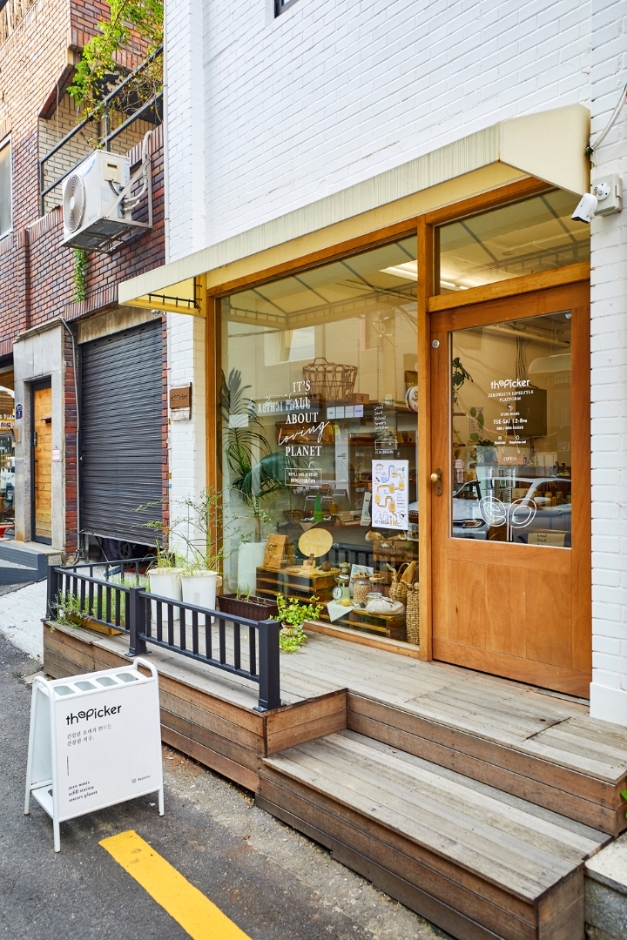Panerai - Lotte Avenuel Branch [Tax Refund Shop] (파네라이 롯데 에비뉴엘점)
6.3Km 2024-04-18
2F, 73, Namdaemun-ro, Jung-gu, Seoul
-
Chaumet - Lotte Avenuel Branch [Tax Refund Shop] (쇼메 롯데에비뉴엘점)
6.3Km 2024-04-23
3F, 73, Namdaemun-ro, Jung-gu, Seoul
-
MyungBo Inc - Lotte Avenuel Branch [Tax Refund Shop] (명보아이앤씨 에비뉴엘)
6.3Km 2024-06-27
73, Namdaemun-ro, Jung-gu, Seoul
-
The Picker (더피커)
6.3Km 2024-01-05
9 Wangsimni-ro 14-gil, Seongdong-gu, Seoul
The Picker is Korea's first zero-waste shop that opened in 2016, and has a sophisticated and comfortable atmosphere. The shop is filled with eco-friendly bathroom products, gardening products, kitchen products, stationery, and more. It is fun to look around as it has many products essential to everyday life made from very environmentally friendly materials such as bamboo toothbrushes, solid perfume, shampoo bars, plastic-free corn floss, natural surfactants like soapnut fruits, and glass and silicone straws.
Olive Young - Myeong-dong Station Branch [Tax Refund Shop] (올리브영 명동역)
6.3Km 2024-04-22
127, Toegye-ro, Jung-gu, Seoul
-
Åland - Myeong-dong Main Branch [Tax Refund Shop] (에어랜드 명동본점)
6.3Km 2024-06-27
40, Myeongdong 8-gil, Jung-gu, Seoul
-
CU - Koreana Hotel Branch [Tax Refund Shop] (cu코리아나호텔점)
6.3Km 2024-06-26
135, Sejong-daero, Jung-gu, Seoul
-
Yongma Falls Park (용마폭포공원)
6.3Km 2024-02-20
250-12 Yongmasan-ro, Jungnang-gu, Seoul
Yongma Falls Park is situated on the mid-slope of Yongmasan Mountain, established following the closure of an aggregate collection plant. The park showcases three artificial waterfalls: Cheongnyongpokpo Falls, Baengmapokpo Falls, and Yongmapokpo Falls. Each waterfall comprises two tiers, with x_heights ranging from 21m to 51.4m. The park is equipped with various amenities, including ponds, tennis courts, soccer fields, a wildflower garden, walking trails, and a barefoot walking trail.
Olive Young - Nowon Branch [Tax Refund Shop] (올리브영 노원)
6.3Km 2024-04-17
#105, and #106, 65, Sanggye-ro, Nowon-gu, Seoul
-
![Panerai - Lotte Avenuel Branch [Tax Refund Shop] (파네라이 롯데 에비뉴엘점)](http://tong.visitkorea.or.kr/cms/resource/42/2890442_image2_1.jpg)
![Chaumet - Lotte Avenuel Branch [Tax Refund Shop] (쇼메 롯데에비뉴엘점)](http://tong.visitkorea.or.kr/cms/resource/65/2890465_image2_1.jpg)
![MyungBo Inc - Lotte Avenuel Branch [Tax Refund Shop] (명보아이앤씨 에비뉴엘)](http://tong.visitkorea.or.kr/cms/resource/62/3314562_image2_1.jpg)

![Olive Young - Myeong-dong Station Branch [Tax Refund Shop] (올리브영 명동역)](http://tong.visitkorea.or.kr/cms/resource/27/2878627_image2_1.jpg)
![Åland - Myeong-dong Main Branch [Tax Refund Shop] (에어랜드 명동본점)](http://tong.visitkorea.or.kr/cms/resource/81/3314381_image2_1.jpg)

![Olive Young - Nowon Branch [Tax Refund Shop] (올리브영 노원)](http://tong.visitkorea.or.kr/cms/resource/69/2888069_image2_1.jpg)
 English
English
 한국어
한국어 日本語
日本語 中文(简体)
中文(简体) Deutsch
Deutsch Français
Français Español
Español Русский
Русский